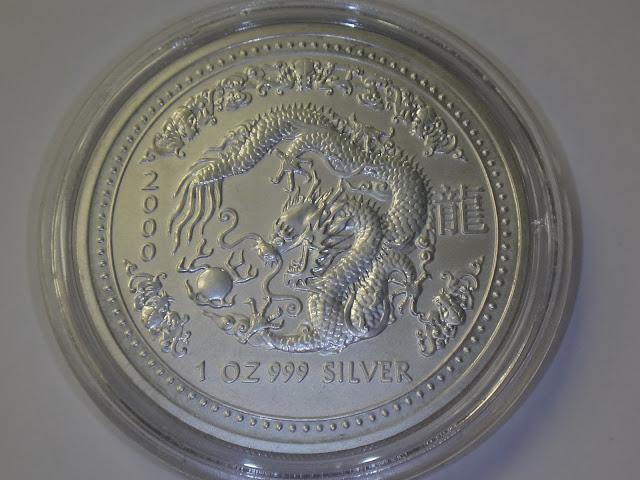 |
Silver disappeared from circulation, but in a few decades it came back in bullion coins |
From the mid-1960s until silver bullion coins were developed in the 1980s, collectors looking for slivers of silver at affordable prices had few options.
The United States famously adopted copper-nickel clad coinage in 1965, striking 1964-dated silver coinage well into the new year while making the transition.
By this point, most other countries had already eliminated or drastically reduced the use of silver for coinage.
Once silver departed circulating coinage in the 1960s, collector and investor choices were limited to older, often worn coins with bullion content or private bullion issues.
Then came the birth of the silver bullion coin, now one of the more avidly collected forms of the metal worldwide.
Not all silver bullion coins are created equal, though, and buyers must be aware of the differences to make educated purchases. For example, not all coins are of the same fineness. Also, while some silver bullion coin mintages are unlimited, some are struck in smaller numbers and may carry higher prices as a collector premium.
In addition, some mints change the design of their silver bullion coins every year to create fresh interest in the series, while others rely on the constancy of a standard flagship design.
What are bullion coins?
Bullion coins are governmentally issued pieces whose value is intended to be based on their precious metal content. The market value of that precious metal is generally much higher than any face value the pieces may carry as a formality.
While most coin collecting guides stress that collecting should be for fun, with potential for profit only an ancillary benefit, that suggestion does not apply equally to bullion coins acquired for investment.
Bullion coins are minted by government and private mints for a variety of countries. Most are considered legal tender in the country whose name they carry. Although primarily purchased as investments, their attractive designs and sometimes rarity mean they are also often prized by collectors.
One important characteristic of bullion coins that sets them apart from collector coins is the way they are sold. Most mints do not offer the bullion coins directly to collectors and dealers because mints are not geared to the business of maintaining the two-way market that the bullion marketplace requires. A two-way market means a seller will also buy a bullion coin back, at prevailing rates. (Mints sell collector coins and sets directly to customers, both collectors and dealers, and similarly don’t buy the coins back. The collector coins trade in the secondary market.)
At the front end of the market, the government mint that produces the coins usually sells them to a few large distributors. The two-way market begins with these distributors, who then sell the bullion coins to a wider network of wholesalers, from whom retailers purchase the coins for sale to bullion coin investors and collectors.
Because the government is not an investment firm, the government does not buy the coins back from distributors. The tiered distribution system’s most important function is to provide the buy-back market that allows investors to perceive a market value for the pieces. However, while large distributors will buy back bullion coins, smaller distributors may be less able to do so, particularly in a rapidly shifting market.
Producers (mints) price the coins based on the value of the metal in the coins at the time of sale. The pricing also includes manufacture, storage, delivery and other costs, but is much closer to a coin’s actual cost than pricing for most collector coins.
World mints charge a premium of a varying percentage above these costs to generate a profit. The percentage of the premium is higher on smaller-sized coins because, per ounce, associated costs are higher. Making and packaging, for example, 10 tenth-ounce coins will cost more than the same for one 1-ounce coin.
Bullion coins are often sold in high finenesses, or with guaranteed silver content at 1-ounce or multiples or fractions of ounces, making the calculation of silver value a matter of simple mathematics. The coins are therefore easy to trade or liquidate, as owners merely need to multiply a “spot” price by a coin’s precious metal weight to arrive at its value at the time of a transaction.
The value of the measure of silver in historic U.S. coins sometimes bought and sold at prices related to their precious metal value is not as simply calculated. For example, one such piece, an average circulated Morgan silver dollar, contains .86 ounce of silver, not a nice round number.
The first world bullion coin
While the concept of silver bullion coins has been developed and expanded over the past 30 years, the idea of a silver bullion coin really originated with the Maria Theresa taler. The .8333 fine silver taler, measuring 39.5 millimeters in diameter, weighing 28.067 grams and carrying her portrait, was issued by more than a dozen mints before her death in 1780. The coin was so famous that restrikes are still struck today by the Austrian Mint with the 1780 date.
“The taler coin long has been accepted internationally, not only in Europe, but in areas of the world where a firm local coinage did not or does not exist,” according to the Coin World Almanac, 8th edition. “It is not the only coin that enjoyed wide acceptance, but it is by far the best known.”


Comments
Post a Comment